Teaching Kids to Shoot
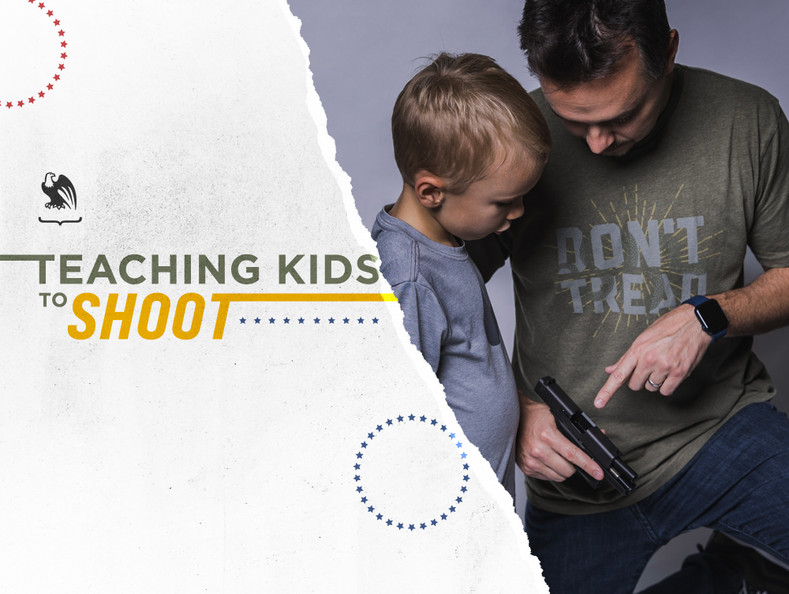
If you’re an avid shooter, it’s only natural that you want to introduce your kids to the sport. But when is the right time to introduce kids to shooting, and what is the best way to go about it?
Teaching kids to shoot is an important, and fun part of being a gun-loving parent. Introducing kids to shooting sports is all about finding the right time, place, and equipment, paired with teaching them the fundamentals of firearm safety, proper form, and what it means to be a responsible gun owner.
In addition to spending quality time with your kids through an activity you enjoy, there are numerous reasons why teaching children about guns is important. Not only can removing the mystery surrounding firearms help keep them safe, but you just may introduce them to a hobby they can enjoy for years to come.
Keep reading for tips on how to successfully teach your kids to shoot.
Why Teach Children to Shoot?
Besides the fact that shooting with your kids can be a fun experience, there are numerous reasons to teach them how to shoot.
First and foremost, teaching kids to shoot takes away the mystery surrounding firearms. We don’t have to tell you that kids are incredibly curious, especially about things they’re not allowed to do/touch.
By being open with your kids about guns and firearm safety, you can satisfy their curiosity and, therefore, the odds that they will be curious enough to handle a weapon without your supervision.
Another reason to teach your kids shooting skills is so they can develop a sense of responsible gun ownership as an adult. Even if your child does not take up hunting, competition shooting, or concealed carrying when they’re grown, they will respect firearms and know how to use one in the event they need to defend themselves.
Additionally, the way you teach your child about firearms will likely carry over into how your grandchildren are taught about them. By training future generations to shoot responsibly, you can help preserve our 2nd amendment rights.
“Learning how to handle a gun properly is paramount. It helps to prevent both unnecessary deaths and to ensure our right to bear arms remains in place,” according to a Texas Gun Club article.
At What Age Should You Teach Kids to Shoot?
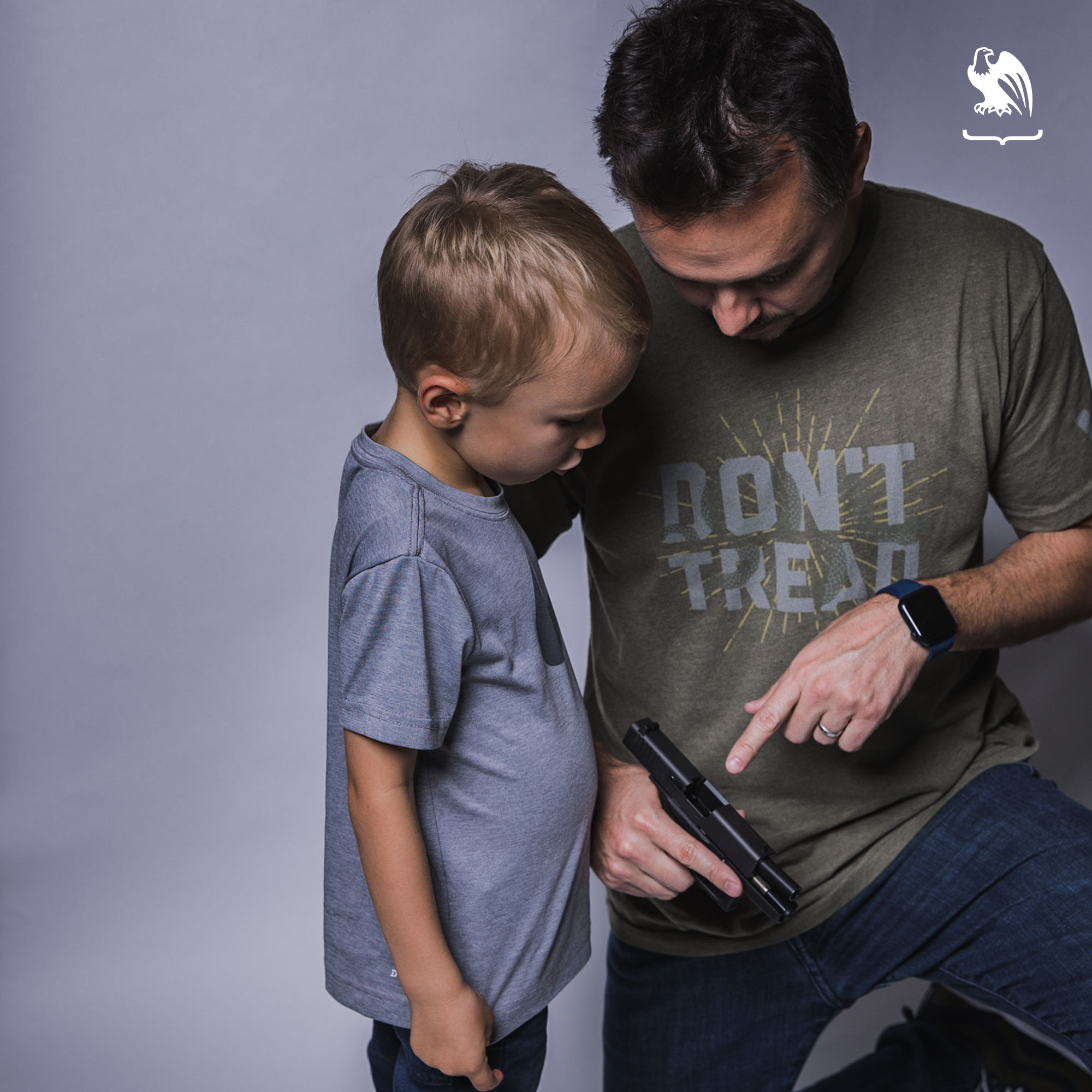
First thing first, you should understand the difference between teaching kids gun safety and actually teaching kids to shoot a firearm.
If you have a weapon in your house, and even if you don’t, it’s important to teach firearm rules to kids (namely, to never touch a firearm without adult supervision) as early as possible. Children as young as 3 have been known to pull triggers.
When it comes to deciding the right age to actually take your child out and teach them to shoot, there is no right or wrong answer. No two kids are the same, and only you can decide when your child is ready to learn how to shoot.
So, how do you know if your child is ready?
The short answer is that it all comes down to their maturity and level of interest in firearms. Since all kids mature at different ages, your child could be 5 or 15 before they are ready to learn how to shoot (and that’s okay!).
It’s best to wait until your child is at a point where you trust them to take safety seriously and they have expressed interest in learning. You should never push a child to shoot who isn’t ready.
Even if your child grew up around firearms, they may still not be prepared to learn to shoot, We The Female Founder Kerry Slone wrote in an article for The Truth About Guns.
“Just because dad is a hunter and a child knows the safety rules doesn’t mean they are comfortable around them. And they may be too afraid or embarrassed to discuss that with their parents,” Slone wrote.
So, start by having conversations about guns with your kids. If you feel they are mature enough to be trusted around weapons, find out whether they are enthusiastic to learn or if they have reservations about shooting. If they show interest, take them to the range! If not, open up the conversation to find out why. Are they afraid of guns? Do they have a negative opinion about them? Are they simply uninterested in the sport? Talk it through and be prepared to answer any questions they may have.
Kids who are uninterested in firearms should still be taught the basics of gun safety, though it’s okay to postpone their first shooting lesson until they feel more comfortable!
Importance of Teaching Kids Gun Safety
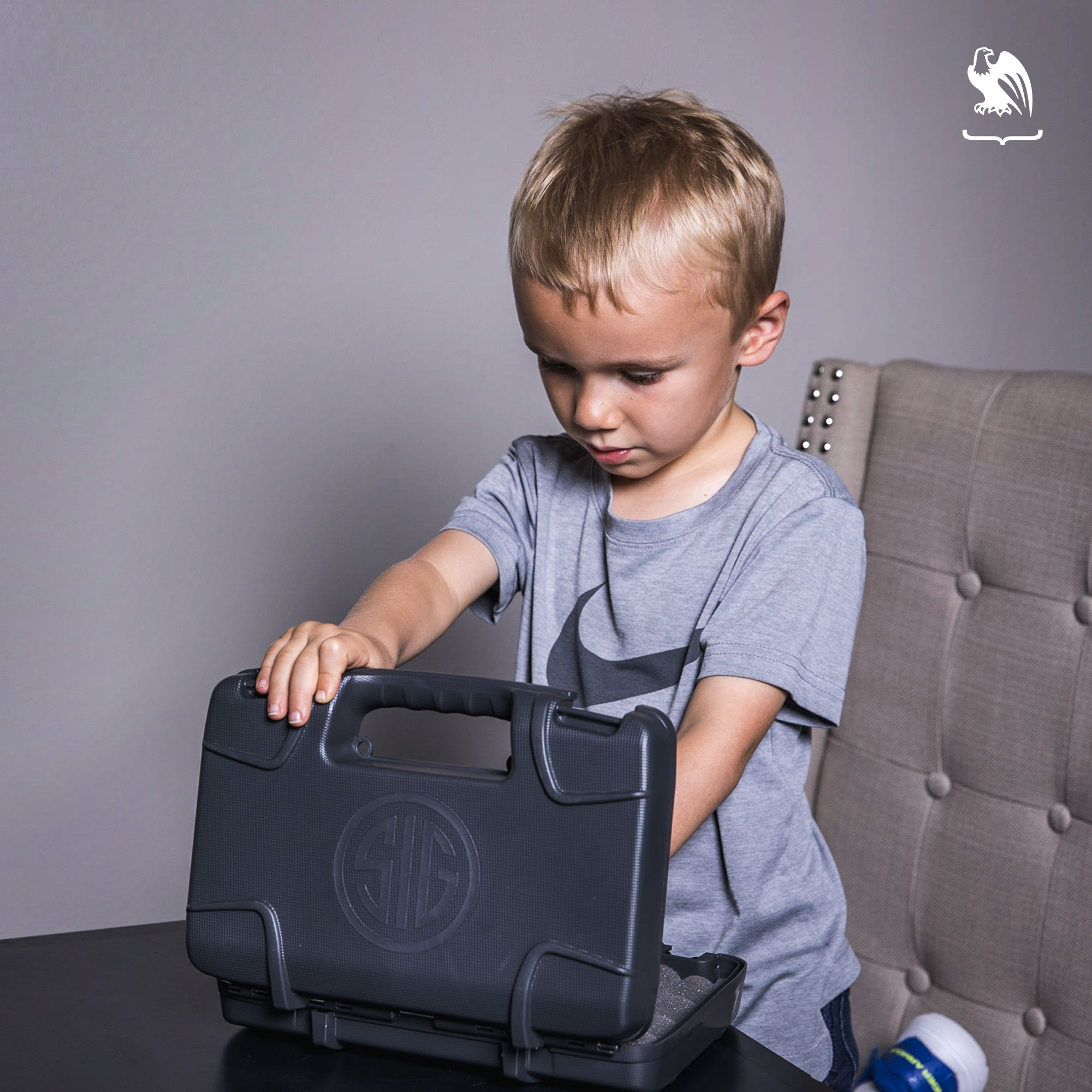
The number one most critical aspect of teaching kids to shoot is talking to them about gun safety. It’s important to ingrain these safety rules in their minds and train them to have a healthy respect for firearms.
You should start by teaching them the difference between real guns and toy guns. They also need to understand the difference between the pretend things they see on TV and reality. Kids are exposed to a lot of media these days, so this is a crucial first step.
Second, before they ever pull a trigger, kids should be taught the four basic rules of firearm safety:
- Treat every gun like it’s loaded (even if it’s not).
- Always keep the gun pointed in a safe direction.
- Keep your finger off the trigger until you’re ready to shoot.
- Be sure of your target and what lies behind it.
Remember: kids learn by watching you. While it’s important to tell your kids the rules of gun safety, it’s even more important to lead them by example. So, practice what you preach, and follow the rules you teach your children. Show them with your actions how to be a responsible gun owner.
The NRA's Eddie Eagle GunSafe® program offers some additional rules about gun safety for kids about what they should do if they ever come across a gun without an adult present.
- Stop: The first thing a child should do if they find a gun is stop and remember the rest of the safety rules.
- Don’t touch: Kids need to know that they should never touch a firearm without the supervision of a trusted adult. Picking up a gun puts a child in danger of accidentally shooting themselves or someone else.
- Run away: This gets the child away from the gun and out of danger, and it also removes the temptation for them to touch it.
- Tell an adult: Kids should always tell their parent, a teacher, or another trusted adult if they come across a firearm.
Keeping weapons out of reach of children is another safety precaution that should be taken as a parent. Even if your kids are well-educated on gun safety, it’s still important to keep your firearms and ammunition locked away in a safe place while not in use. No matter how much you trust your children, kids can be unpredictable.
Even if your child would never touch a gun without your supervision, they likely have friends that come over to your house from time to time. So, keep your weapons secured in a safe, locked in a drawer, or up on a high shelf where they can’t reach with a trigger lock securing them.
Where is the Best Place to Take Kids Shooting?
The best location for you to take your child shooting will depend on what you have access to and the experience you’re looking for.
Taking your kid to the range for their first time shooting can be a great experience. It’s a controlled environment where you can safely show them gun basics. Most ranges also have easy-to-move targets that you can adjust so your child can practice at varying distances. Plus, shooting ranges are just fun!
Whether you choose an indoor or outdoor range is up to you. There are definitely pros and cons to each, which you can learn more about in our article here.
Shooting in the country or wilderness is also a great place to teach your kids about guns. This option allows you more time and privacy, which can make timid young shooters more comfortable. It also gives you an opportunity to teach your child how to ensure they’re shooting against a proper backstop. The best part is, it’s free!
Wherever you go, make sure you choose a comfortable environment for your child to learn. Heading to the range during peak hours is probably not the best place to teach a child that may be a little jumpy at first.
What is the Best Gun For Kids to Shoot?
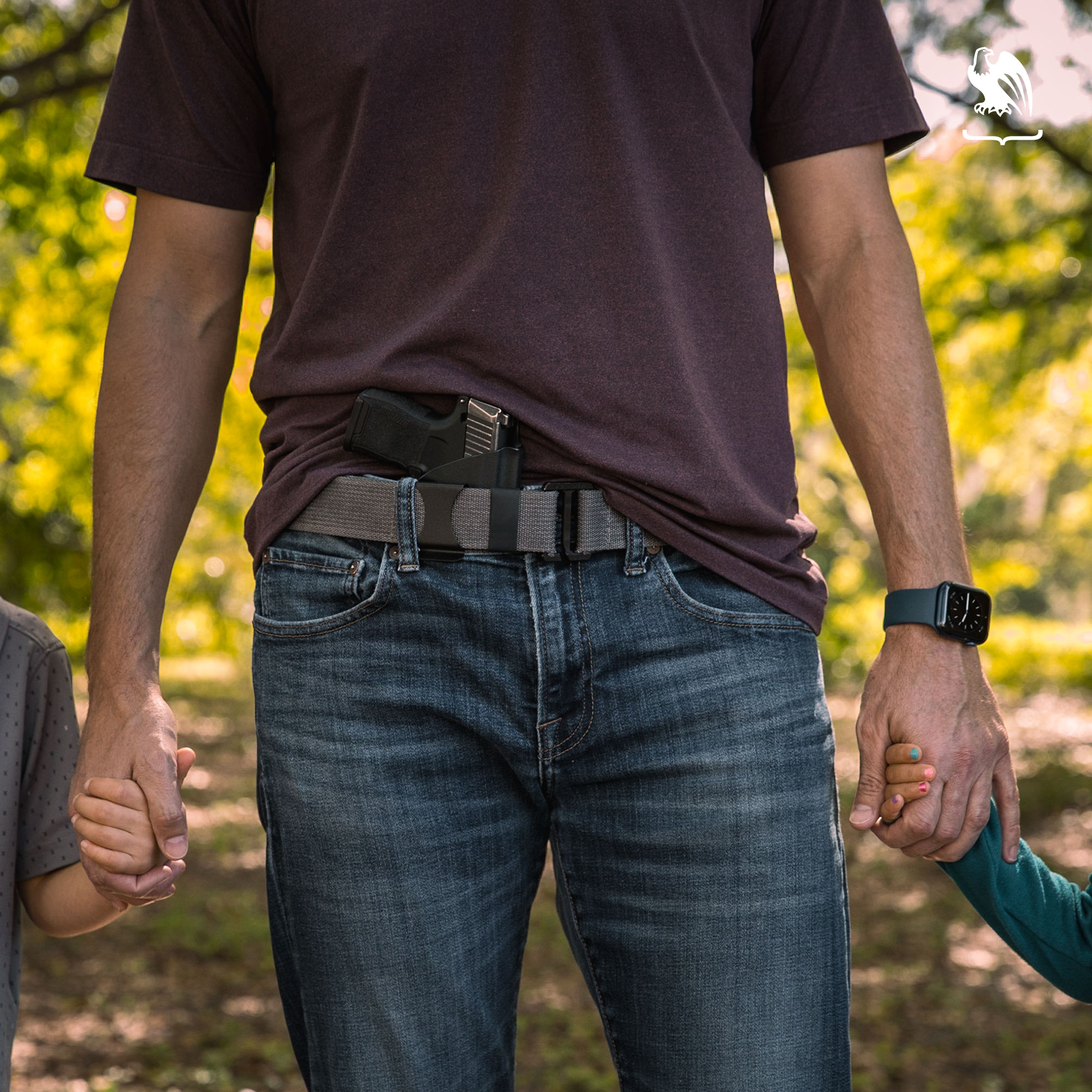
Kids … are small. Or at least smaller than us. If you give your 7-year-old a full-sized 12 gauge shotgun to take their first shot with, odds are it won’t go well. Giving your child a firearm that’s difficult for them to hold, kicks like a mule, or is an otherwise bad experience could turn them off from shooting forever.
So, what gun should you start your kid with?
While there’s no specific model or caliber that you have to start your child with, the first gun you put in their hands should be a smaller weapon without a lot of recoil. Some rifles are actually built for children and make great teaching weapons. If you don’t have access to one of these, NRA Familyrecommends starting a child out with a smaller rifle, like a .22 caliber or pellet gun, which will be easy for them to hold and shoot.
Pistols should be saved for when your child is a little more experienced as they’re easier to accidentally point where they shouldn’t. However, an airsoft pistol could be a good weapon to start your child with if they’re itching to shoot a handgun or you don’t have a smaller rifle for them to use.
How to Teach Kids to Shoot
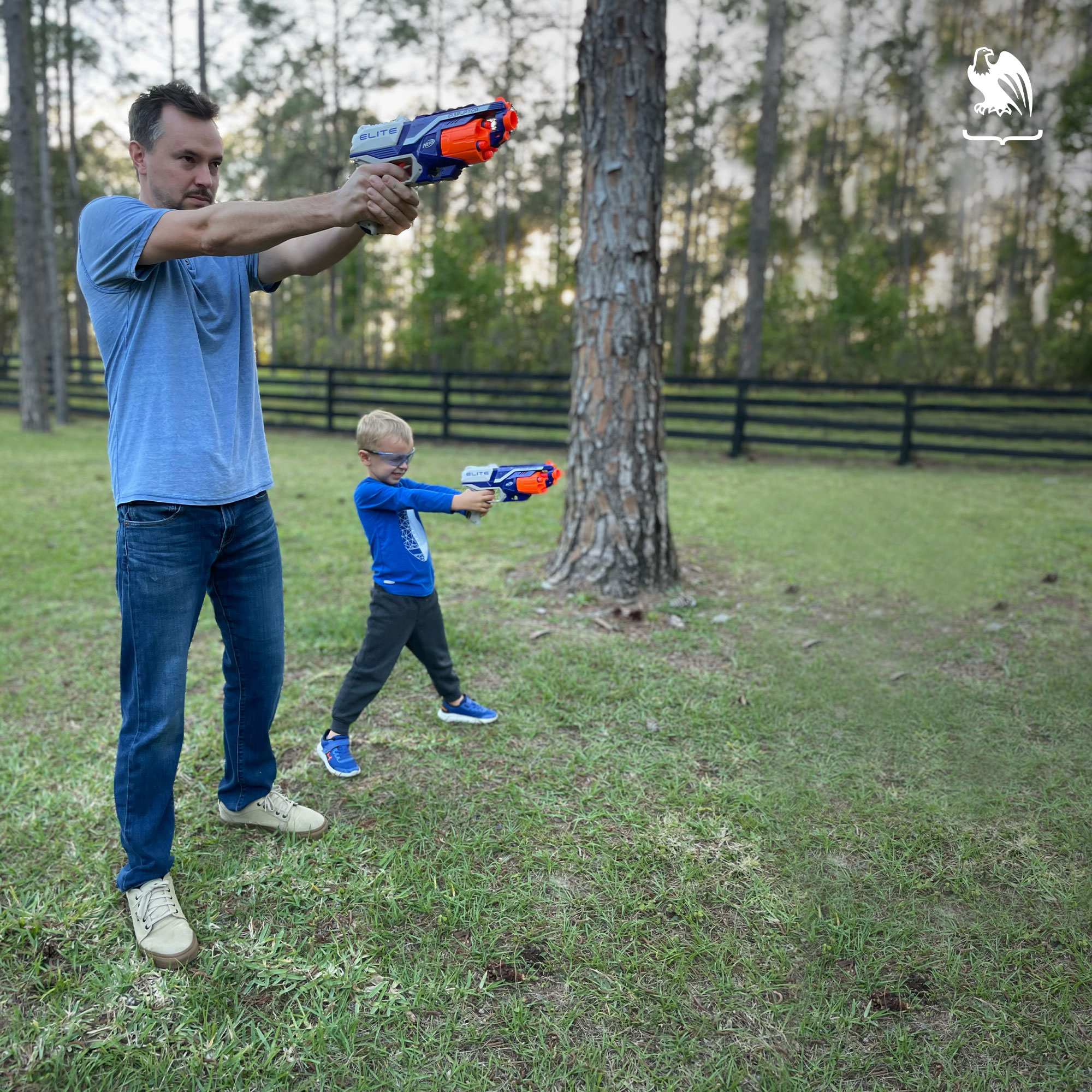
Okay, so you’re ready to take your child out for their first shooting lesson. Before you get started, it’s a good idea to ask them if they have any questions. Talk through any queries or concerns they may have, then get started with the fun part.
Gun Anatomy
Start out by giving your kid a brief lesson on firearm anatomy and functions. In an article for Mossberg, Firearms writer Jason Cruis advises that you should only spend about 5-10 minutes educating your child on how guns work, and you should keep it as simple as possible.
Children don’t need to know all about internal ballistics at first; it will likely only confuse them. Start with the basics. Point out the stock, the trigger, and the sites to them. Show them how to load the weapon. Keep it brief and informative. The idea is to familiarize your child with the language and anatomy of firearms so they feel more comfortable and build a foundation from which they can continue to learn.
Shooting Fundamentals
When it comes time to put the gun in your child’s hands, it’s always best to start with an unloaded gun. Make sure you empty your firearm and show your child that it is, in fact, unloaded. Let them hold the gun and practice taking aim. It can’t hurt to go through a few dry fire drills as practice before you ever put a round in the weapon.
Now is the time to show your child how to aim with one eye open, how tightly to hold the firearm, and how hard they need to pull the trigger. Make sure they understand what they need to do with the gun once the shot is fired, always keeping it pointed in a safe direction.
Take this opportunity to teach your child proper form. When you’re first learning how to shoot, it can be easy to hyperfocus on aiming and pulling the trigger and forget how you’re actually holding the gun. Make sure you help them position their feet, show them proper hand placement, and don’t let them lean too far forward or backward.
When they are ready to shoot, start with a single round. It’s best to let your youngster fire once, then reload, rather than cycling a shell while they’re still learning.
“I’m a huge advocate of ‘one and done,’” Cruis said. “That is, they shoot once, and they do not use the pump to cycle a shell. It’s just safer.”
Once your child is comfortable shooting at a simple paper target, you may want to try mixing it up a little bit. Try replacing a paper target with something like a water bottle or clay pigeon that will break or disappear when they hit it. Or, try taping some balloons onto a target. It adds an element of fun and gives them a visual queue when they’ve successfully hit their mark.
It’s important that you take your turn shooting, too. Not only does it add to the fun, but it helps them to see how you handle the firearm and gives them an example of proper shooting techniques to learn from (this is especially important for visual children!).
As your child is shooting, give them tips and tricks for how to narrow their aim and improve their shooting skills. Be careful not to be overly critical while they’re still learning, though. Their first time shooting should be primarily about safety, getting comfortable with firearms, and having fun. More serious training can come later when they’re more experienced.
Cleaning and Caring for Firearms
Once your child is familiar with shooting, showing them how to properly clean and care for a gun can give them a deeper respect and understanding of firearms. Allowing them to help you disassemble and clean a weapon will help them better understand how guns work, which is never a bad thing!
Further Education
Once your child has mastered the basics of shooting, it might be good to enroll them in a hunter’s safety course or other kid-friendly shooting class designed to teach kids shooting guns. This will get them excited about shooting and allows them to dive deeper into the sport and learn more about shooting and maintaining weapons.
Even if your child has no interest in hunting, a hunters safety course is a good option for kids who are old enough as they usually go over things like ballistics, gun safety, and shooting techniques more in-depth. Plus, they’re usually pretty inexpensive!
Summary
Successfully teaching kids to shoot is all about getting on their level. It’s important to teach them about firearm safety, proper form, and gun basics in a way they understand and in a way that helps them grasp the seriousness of handling weapons.
Introducing them to shooting sports should be done in a controlled environment with an easy-to-shoot gun. It’s essential to start by teaching them the fundamentals of gun safety and helping them understand the difference between real firearms and toys.
When done in a safe and proactive manner, introducing your kids to shooting can both help keep them safe and provide an activity for you to enjoy together.
If you are looking for belts or holsters, check out some of our Vedder Holsters products here. Like everything we sell, our holsters and gun belts are covered by a Lifetime Warranty and a 30-day money-back guarantee.
Looking for items beyond holsters and belts? Check out our Resources Page for popular product links like lights, lasers, first aid, maintenance, and more.

